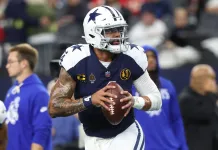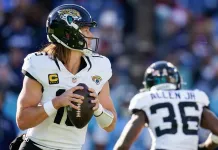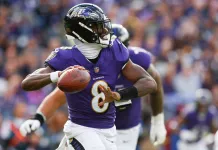DeAndre Hopkins and the myth of the No. 1 receiver
In her book, A Conjuring of Light, V.E. Schwab wrote: “Myths do not happen all at once. They do not spring forth whole into the world. They form slowly, rolled between the hands of time until their edges smooth, until the saying of the story gives enough weight to the words—to the memories—to keep them rolling on their own.” The NFL offers plenty of myths, and perhaps the biggest one is “the No. 1 receiver.” This myth of the league being filled with No. 1 receivers followed Schwab’s path perfectly.
Commentators and experts toss out the phrase as if there were 50 No. 1 receivers all throughout the league. They don’t understand how hard it is to be a No. 1 receiver, acting as if every team in the NBA had a player like Michael Jordan. Being a No. 1 requires a skill set like Jordan, being able to dominate when double-teamed, able to put the ball into the end zone, able to get open on the most critical downs and impossible to take out of the game with coverage. Who fits that description? Maybe six to eight players total. Maybe. When we get to the wide receivers on the GM Shuffle Blue/Red Chip ratings, I will give out the list.
Part of the myth-generating issue lies within. We as a society have a hard time making the distinction from what is good to what is great. It’s why the Hall of Fame is upside down. Tommy McDonald and Randy Moss are both Hall of Fame receivers, yet there is a world of difference in their skill set and on-the-field production. Tommy might be in the Hall, but he was never a No. 1 receiver, and Moss was a No. 1 from his rookie season. We tend to overrate, overpraise, and because a player is making a large sum of money, we naturally assume the player is great. Currently, 18 wide receivers are making over $18 million per season. Are all of them No. 1 receivers? No. Christian Kirk from Jacksonville isn’t one. Neither is Keenan Allen, or Terry McLaurin. They are good players, but they don’t place the fear of God into defensive coordinators. They are solid, not elite.
When I worked in the league, players that occupied my mind on the bus ride to the stadium were the ones that fit into the elite class. Knowing Moss scored a touchdown on every 6.29 passes he caught made me shake in my boots. Or Terrell Owens scoring once every 7.04 catches qualifies as frightening. Former Miami Dolphins great Paul Warfield scored once every five catches—now that is a No. 1 receiver. Getting the ball into the end zone is what matters most. Davante Adams scores every 8.83 passes he catches. Tyreek Hill scores every 9.09. Adams and Hill are No. 1 receivers.
This notion that DeAndre Hopkins is a No. 1 receiver is another myth. Hopkins is an excellent receiver with elite hands, body control and catch radius. He is always covered and does not have great speed or separation quickness, yet somehow, he makes a play on the ball. Hopkins wins with his ability to push, nudge and then snatch the ball—not with his athletic talent. He worries the defense, but he never scares them. Hopkins scores touchdowns every 12 catches, and at age 31, he isn’t going to improve on his skills, as we know each week he struggles to practice. We also know he was suspended for six weeks last year for taking performance-enhancement drugs, an indication Hopkins wanted to improve his aging skill set. Does this make him a bad player? No. Does this mean he won’t help the Titans? Again, no—he is an upgrade. It only means he isn’t a No. 1, regardless of the paycheck.
By adding Hopkins, the Titans improved their team, especially at the wide receiver position. How couldn’t they improve as they were in dire straits? Just examine their depth chart. Their two leading pass catchers from a year ago, Robert Woods and Austin Hooper, are no longer on the team. Treylon Burks, their first-round draft choice last year, returns with hopes he can build off of his last two games of the season when he was targeted 15 times and had eight catches and two touchdowns.
Because the Titans were desperate for skill players, they overpaid for Hopkins’ services, which all teams must do from time to time based on their situation. They blew the competition out of the water with their offer. Yes, Kansas City, Buffalo and New England all had interest, but to overpay for those teams wasn’t a wise investment.
Many believe New England needed a No. 1 receiver, which most teams need—and since Hopkins isn’t a No. 1, why would they pay $26 million for two years? They signed JuJu Smith-Schuster to play the slot. Last year for the Chiefs, Smith-Scuster had 78 catches for a 12-yard average and scored three times. Good, not great numbers, but at $8.5 million per year, with Smith-Schuster only being 26 years old, the deal seems more logical. Unless you believe Hopkins is a No. 1 receiver—which is an exaggeration. By the way, look at the numbers produced by Hopkins after leaving Houston. He is 1.4 yards less per catch—and his touchdown ratio went from 11.7 with the Texans to 18.8 with the Cards.
Once again, the overpaying is not a knock against the Titans, simply the reality of their situation. Hopkins will become quarterback Ryan Tannehill’s best friend, especially on third down, where they ranked 23rd overall. Hopkins can make the tough catch to keep the chains moving, yet because he is the only threat on third down, he will be doubled all over the field, thus putting pressure on Burks and Nick Westbrook-Ikhine to produce. Adding Hopkins won’t change their offensive philosophy as the Titans need to run the ball, play sound defense and be opportunistic in the red zone—which they were last year, ranking sixth overall.
Their recipe for winning works. However, they have no margin for error. If they get behind, have to play catch-up and cannot use their run-action passing game to move the ball, they are in trouble. The Titans don’t want, nor do they have, an elaborate dropback pass game, and when forced to use one, they are vulnerable to mistakes. They must play their style, and their head coach Mike Vrabel understands how to win. More importantly, he knows how to manage the game to give his team the best chance to win. The Titans with Vrabel will never be flashy or explosive, but they will win critical game situations. With some of the new additions to their team—most notably Azeez Al Shaair at linebacker, and Sean Murphy-Bunting at corner, the Titans assuming they can stay healthy, should be able to compete for the South title.
Currently, their win total is at 7.5, and playing in the South with new rookie quarterbacks starting for the Colts and Texans, makes me love the Over. Forget the Will Levis conversation of him being the starter for the Titans. He couldn’t beat our Sean Clifford at Penn State. How is he going to beat out Tannehill during his rookie season? No chance.
I trust Vrabel. I love their defense, and adding Hopkins can help—but let’s not buy the myth that he is a No. 1 receiver.





